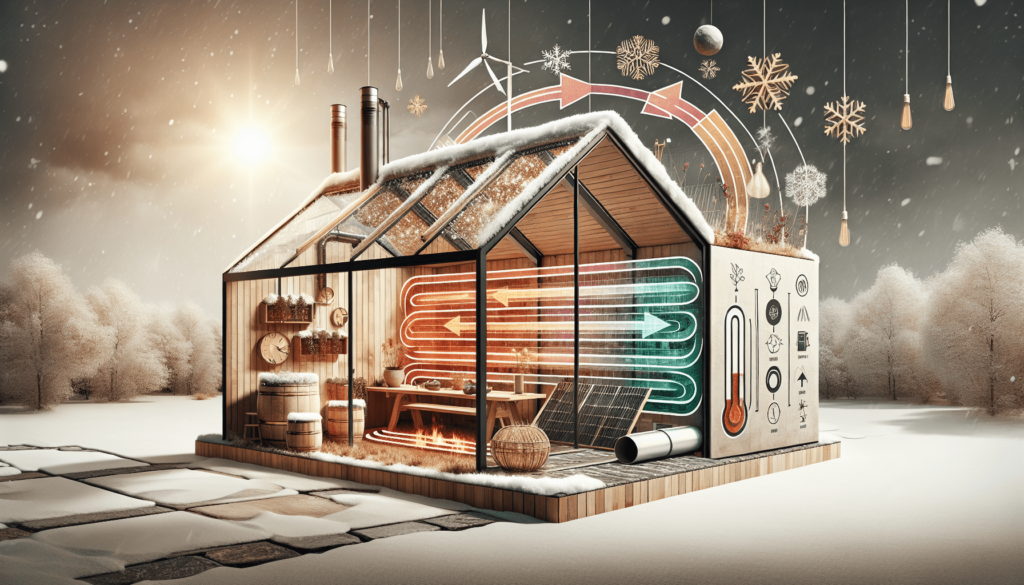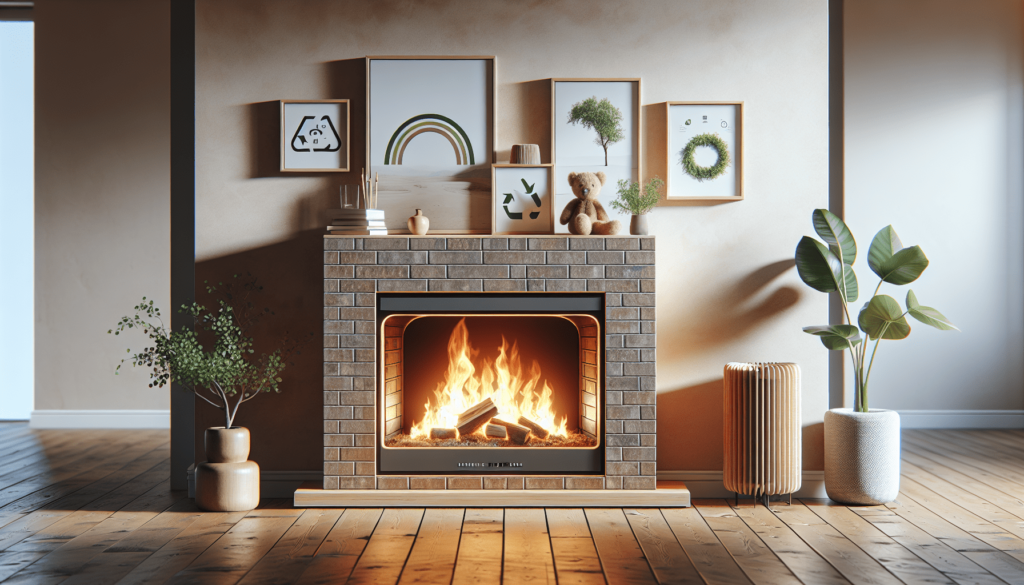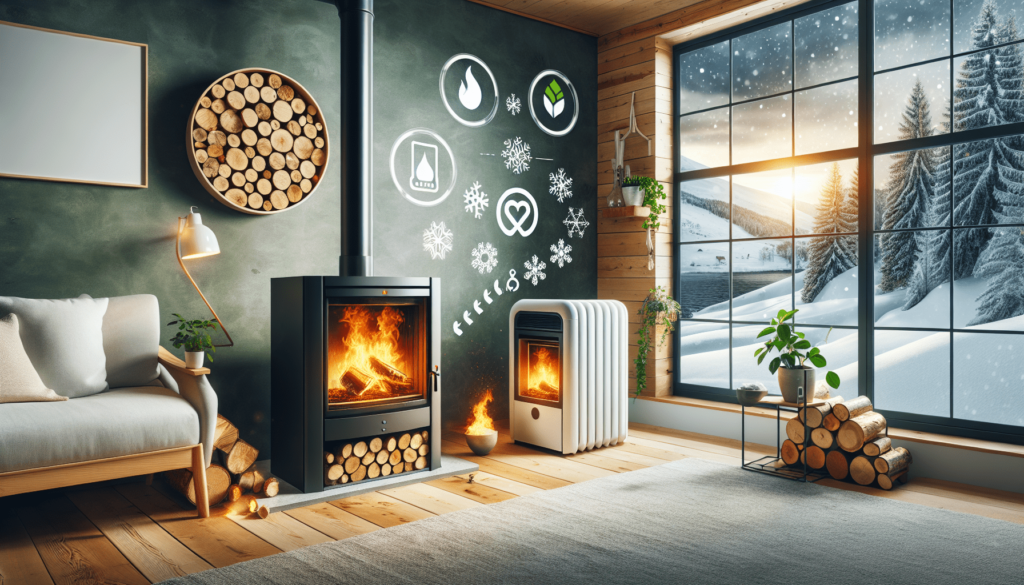Winter is just around the corner, and with dropping temperatures comes the need for a reliable and efficient heating system to keep your home warm and cozy. In this article, we will explore a range of sustainable winter heating options that not only provide comfort but also help reduce your carbon footprint. From energy-efficient heat pumps to radiant floor heating, you’ll discover innovative and eco-friendly ways to stay toasty throughout the cold season. Get ready to explore the world of sustainable winter heating options for your home!

Solar Heating Systems
When it comes to sustainable winter heating options for your home, solar heating systems are a great choice. Harnessing the power of the sun, these systems can provide warmth and comfort during the colder months.
Passive Solar Heating
Passive solar heating is a cost-effective and energy-efficient way to heat your home. This system utilizes the design and materials of your home to absorb and store heat from the sun. Features such as south-facing windows, thermal mass materials, and proper insulation help to capture and retain solar heat, reducing the need for additional heating sources.
Active Solar Heating
Active solar heating systems, on the other hand, use mechanical devices such as solar collectors and pumps to actively collect and distribute solar heat throughout your home. These systems can be used to heat air or water, depending on your needs. Active solar heating is ideal for areas with abundant sunlight and can significantly reduce your reliance on traditional heating methods.
Solar Air Heating
Solar air heating is a type of active solar heating system that utilizes solar collectors to heat air, which is then circulated throughout the home. This can be achieved through various methods, including using solar panels to heat air that is then blown into the living spaces or utilizing solar walls that collect and heat air within a specially designed cavity. Solar air heating can be a cost-effective and environmentally friendly alternative to traditional heating systems.
Solar Water Heating
Solar water heating systems use the sun’s energy to heat water for household use. These systems typically consist of solar collectors, storage tanks, and circulation pumps. The sun’s rays heat the water within the collectors, which is then stored in the tanks for use as needed. Solar water heating systems are an excellent option for reducing energy consumption and can be utilized for various purposes, including space heating, domestic hot water, and swimming pool heating.
Geothermal Heat Pumps
Geothermal heat pumps are another sustainable winter heating option for your home. These systems utilize the stable temperature of the Earth to heat and cool your living spaces.
Horizontal Loop
A horizontal loop geothermal heat pump system utilizes a network of pipes buried horizontally in trenches just below the surface of the ground. The pipes contain a refrigerant that absorbs heat from the ground during the heating season and transfers it to the heat pump inside your home. This process is reversed during the cooling season, with heat being transferred from your home back into the ground.
Vertical Loop
Vertical loop geothermal heat pump systems involve drilling deep vertical boreholes into the ground. Pipes are then inserted into the boreholes and connected to the heat pump system inside your home. This type of system is suitable for homes with limited land space, as the vertical boreholes require less physical area but can reach greater depths, accessing the stable temperatures of the Earth.
Pond/Lake Loop
If you have a pond or lake on your property, a pond/lake loop geothermal heat pump system may be an excellent heating option for your home. In this system, pipes are submerged in the water, allowing heat to be transferred to or from the water to heat or cool your home. This method is often cost-effective and provides efficient heating and cooling.
Open Loop
Open loop geothermal heat pump systems use a water source, such as a well or nearby body of water, as a direct heat exchange medium. The system pumps water from the source into the heat pump, where heat is exchanged and used to heat or cool your home. The water is then returned to the source or discharged. Open loop systems can be highly efficient, but require a suitable water source and proper water treatment.
Closed Loop
Closed loop geothermal heat pump systems are the most common and reliable type of geothermal system. They utilize a network of pipes installed in the ground, filled with a heat transfer fluid, usually a mixture of water and antifreeze. As the fluid circulates through the pipes, it absorbs heat from the ground in the winter and transfers it to the heat pump. In the summer, the process is reversed, with heat being extracted from your home and transferred back into the ground. This closed loop system can significantly reduce energy consumption and provide consistent heating and cooling throughout the year.
Biomass Heating
Biomass heating systems are an eco-friendly alternative to traditional heating methods that rely on fossil fuels. These systems utilize organic materials, such as wood, agricultural residues, and dedicated energy crops, to generate heat for your home.
Wood Pellet Stoves
Wood pellet stoves are a popular choice for biomass heating. These stoves burn compressed wood pellets, which are made from byproducts of the wood manufacturing industry. Wood pellet stoves are highly efficient and produce minimal emissions, making them a sustainable and clean heating option.
Wood Log Stoves
Wood log stoves are a more traditional form of biomass heating. These stoves burn logs or firewood to generate heat. They can be a cost-effective option, especially if you have access to a local source of firewood, but require regular maintenance and attention to ensure optimal performance.
Wood Chip Furnaces
Wood chip furnaces are another biomass heating option that utilizes wood chips as a fuel source. These furnaces are typically larger than pellet stoves and can provide heat for larger homes or commercial buildings. Wood chip furnaces require regular fuel replenishment and proper ash disposal, but they can be a sustainable and economical choice for heating.
Wood Pellet Furnaces
Wood pellet furnaces are similar to wood pellet stoves but are designed to provide central heating for the entire home. These furnaces can be connected to existing ductwork and distribute heat throughout the house. Wood pellet furnaces offer a convenient and efficient way to heat your home with biomass.
Biomass Boilers
For larger heating needs, biomass boilers are an excellent option. These boilers burn organic materials and can provide heat for both space heating and domestic hot water. Biomass boilers can be fueled by wood pellets, wood chips, or other biomass materials, making them a versatile and sustainable choice for winter heating.
Heat Pumps
Heat pumps are highly efficient heating systems that can extract heat from the air, ground, or water to warm your home. They can be an excellent choice for sustainable winter heating.
Air Source Heat Pumps
Air source heat pumps extract heat from the outdoor air and transfer it indoors to heat your home. These systems work efficiently even in cold climates and can provide both heating and cooling. Air source heat pumps can be installed as separate units or utilized as a ducted system connected to your existing ductwork.
Ground Source Heat Pumps
Ground source heat pumps, also known as geothermal heat pumps, extract heat from the ground through underground pipes filled with a heat transfer fluid. This fluid absorbs heat from the ground and is then transferred to the heat pump, which uses it to heat your home. Ground source heat pumps offer consistent and efficient heating and cooling throughout the year.
Water Source Heat Pumps
Water source heat pumps use a water source, such as a well or nearby body of water, to extract heat. Similar to ground source heat pumps, these systems utilize underground pipes filled with a heat transfer fluid to absorb heat from the water and transfer it to the heat pump. Water source heat pumps work well in areas with a reliable water source and can provide efficient heating and cooling for your home.

High-Efficiency Gas Heating
High-efficiency gas heating systems provide a clean and efficient way to heat your home during the winter months. These systems utilize natural gas or propane as a fuel source and can offer significant energy savings.
Condensing Gas Boilers
Condensing gas boilers are highly efficient heating systems that extract heat from combustion gases. These boilers utilize the latent heat of vaporization to preheat the water supply, reducing fuel consumption and increasing overall efficiency. Condensing gas boilers are an excellent choice for homeowners looking to maximize energy savings and reduce their carbon footprint.
Gas Furnaces with High Annual Fuel Utilization Efficiency (AFUE)
Gas furnaces with high Annual Fuel Utilization Efficiency (AFUE) ratings are designed to convert a high percentage of fuel into usable heat. These furnaces utilize advanced burners and heat exchangers to extract as much heat as possible from the fuel. High AFUE gas furnaces provide reliable and efficient heating, ensuring your home stays warm while minimizing energy consumption.
Gas Fireplaces with High Efficiency
Gas fireplaces offer a convenient and efficient way to heat specific areas of your home while adding ambiance. High-efficiency gas fireplaces utilize advanced burner technology and ceramic glass doors to maximize heat output and minimize heat loss. These fireplaces can be a stylish and energy-efficient addition to your home’s heating system.
Electric Heating Options
Electric heating options are a clean and reliable way to keep your home warm during the winter months. While electricity is often more expensive than other fuel sources, electric heating systems can still be a sustainable choice when combined with renewable energy sources.
Heat Pump Systems
Electric heat pump systems utilize the same technology as air source, ground source, or water source heat pumps but are exclusively powered by electricity. These systems extract heat from the surrounding air, ground, or water and transfer it indoors to heat your home. Electric heat pump systems provide energy-efficient heating and cooling and can be a good choice if renewable electricity sources are available.
Infrared Heating
Infrared heating works by emitting infrared radiation that directly heats objects and surfaces in a room, rather than heating the air. Infrared heaters can be particularly useful for heating specific areas, such as bathrooms or home offices, as they provide instant warmth and do not require preheating. While infrared heating may not be suitable for heating larger spaces, it can be an efficient and comfortable option for smaller areas.
Electric Radiant Floor Heating
Electric radiant floor heating is a luxurious and energy-efficient way to heat your home. This system consists of electric cables or mats installed beneath the flooring, which radiate heat upwards, providing a warm and comfortable environment. Electric radiant floor heating can be used as the primary heating source or as a supplemental option in specific rooms, such as bathrooms or kitchens.
Electric Baseboard Heating
Electric baseboard heating utilizes electric resistance elements housed within baseboard units. This system provides heat through convection and radiation, heating the air in the room and warming surrounding surfaces. Electric baseboard heating is easy to install and can be controlled individually for each room, allowing for personalized comfort levels. While it may not be the most energy-efficient option, electric baseboard heating can be a suitable choice for supplemental heating in specific areas of your home.

Hydronic Heating
Hydronic heating systems use hot water or steam to heat your home. These systems are versatile, energy-efficient, and provide excellent heating performance.
Radiant Floor Heating
Radiant floor heating is a popular type of hydronic heating system that provides comfortable and consistent warmth. It involves installing pipes or electric mats beneath the flooring, which circulate hot water or heat the flooring directly. Radiant floor heating evenly distributes heat, eliminating uneven temperature zones and providing a cozy and comfortable environment.
Radiators
Radiators are another common type of hydronic heating system. These devices are connected to a central boiler that heats the water, which is then circulated through the pipes and into the radiators. The hot radiators emit heat into the room through convection, warming the air and creating a comfortable living space. Radiators come in various styles and sizes, allowing you to choose the design that best fits your home’s aesthetic.
Heat Exchangers
Heat exchangers are an essential component of hydronic heating systems. They transfer heat from the hot water source, such as a boiler or heat pump, to the water that circulates through the heating system. Heat exchangers can be used in both radiant floor heating and radiator systems, ensuring efficient heat transfer and optimal heating performance.
Wood Burning Options
Wood burning options offer a rustic and traditional way to heat your home during the winter months. While they may require more effort and maintenance compared to other heating methods, wood burning options can contribute to a sustainable and cozy living environment.
Fireplaces
Fireplaces are a timeless and charming feature of any home, providing warmth and ambiance. Wood-burning fireplaces can be used not only as a heating source but also as a focal point in your living space. However, it’s important to note that traditional open fireplaces can be inefficient and allow a significant amount of heat to escape through the chimney. Consider utilizing fireplace inserts or closed combustion fireplaces to improve energy efficiency and heat output.
Wood Stoves
Wood stoves are a popular heating option, particularly in rural areas. These stoves burn logs or firewood and can efficiently heat a specific area or the entire home, depending on their size and design. Wood stoves often feature a glass door, allowing you to enjoy the sight of the flames while keeping the heat inside. They require regular fueling and maintenance but provide a cozy and comforting warmth.
Pellet Stoves
Pellet stoves offer a convenient and sustainable option for wood burning heating. These stoves burn compressed wood pellets, which are made from byproducts of the wood manufacturing industry. Pellet stoves are highly efficient, produce minimal emissions, and can be easily controlled with programmable thermostats. They are a cleaner and more convenient alternative to traditional wood stoves, providing consistent heat with minimal effort.

Efficient Insulation
Efficient insulation is crucial for maintaining a comfortable and energy-efficient home during the winter months. Proper insulation can minimize heat loss, reduce energy consumption, and ensure consistent indoor temperatures.
Insulate Walls and Attics
Insulating your walls and attics is one of the most effective ways to improve energy efficiency. Insulation materials, such as fiberglass, cellulose, or foam, are installed within the walls and attic spaces to reduce heat transfer. This prevents warm air from escaping and cold air from infiltrating your home, keeping it cozy and warm.
Seal Air Leaks
Air leaks can significantly contribute to heat loss in your home. It’s important to inspect for drafts and seal any gaps or cracks around windows, doors, vents, and electrical outlets. Weatherstripping, caulk, or spray foam can be used to seal these areas and prevent cold air from entering and warm air from escaping.
Double or Triple Glaze Windows
Windows are a common source of heat loss in homes. Upgrading to double or triple-glazed windows can minimize heat transfer, improve insulation, and reduce energy costs. These windows feature multiple layers of glass separated by insulating gas, which provides superior thermal performance compared to single-pane windows.
Insulate Pipes
Insulating your hot water pipes can prevent heat loss and reduce energy consumption. Pipe insulation sleeves or wrap can be easily installed around exposed pipes, helping to maintain water temperature as it travels from the water heater to your faucets or radiator systems. Insulating pipes also helps prevent freezing during cold winter months.
Energy-Efficient Home Design
Implementing energy-efficient home design principles can significantly contribute to sustainable winter heating. By optimizing your home’s design and layout, you can reduce energy consumption and create a comfortable living environment.
Passive Solar Design
Passive solar design utilizes the sun’s energy to heat and cool your home naturally. This design approach takes into consideration elements such as window placement, orientation, and shading to maximize solar heat gain during the winter. By capturing and storing solar heat, passive solar design reduces the need for additional heating sources and lowers energy costs.
Proper Window Placement
Strategic window placement can play a significant role in heating your home efficiently. Windows on the south side of your home allow for maximum solar heat gain during the winter months, while minimizing heat loss. East and west-facing windows should be properly shaded to reduce heat gain during the summer and heat loss during the winter.
Thermal Mass
Using thermal mass materials in your home can help regulate indoor temperatures and improve energy efficiency. Materials such as concrete, brick, or stone have a high thermal mass, meaning they can absorb and store heat from the sun during the day and release it gradually at night. This helps maintain a more stable indoor temperature and reduces the need for excessive heating or cooling.
Insulated Doors
Insulated doors provide an effective barrier against heat loss and drafts. Upgrading to insulated exterior doors, particularly those with weatherstripping and airtight seals, can significantly improve energy efficiency and comfort. Additionally, installing storm doors can provide an extra layer of insulation and protect against drafts.
In conclusion, there are numerous sustainable winter heating options available for your home. From solar heating systems to geothermal heat pumps, biomass heating to heat pumps, high-efficiency gas heating to electric heating options, hydronic heating to wood burning options, efficient insulation to energy-efficient home design, each option offers its unique benefits and considerations. By exploring and implementing these sustainable heating methods, you can reduce your energy consumption, lower your carbon footprint, and create a cozy and comfortable living environment during the winter months.


